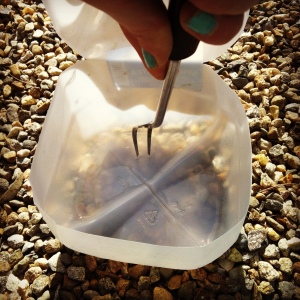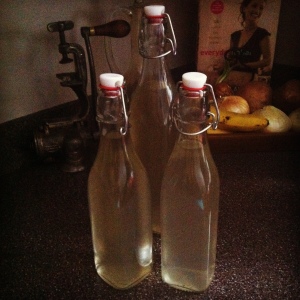Did you know that eating fat doesn’t make you fat? It’s true!
That stuff they call margarine isn’t real food either. It’s gross, it’s harmful and you should stop using it! But you don’t really use that junk, right?
Real food is always better. Always. But even the ones you think are real and wholesome aren’t always as they seem. Take butter for instance. Did you know that butter, yes, the real kind, usually has added preservatives? It’s sad but true. But there’s hope.
Making butter is ridiculously easy!
Cream, a mason jar and twenty minutes easy.
Fill a mason jar half way with heavy cream.
Put the cover on.
Now shake the day lights out of it!
Shake, shake, shake…
Shake, shake, shake….
The cream will get thick. Keep shaking.
When you think something MUST have gone wrong, keep shaking.
You are almost there….
And then all of sudden, it will happen! The thick cream will separate – buttermilk and butter.
Strain the buttermilk….
But save it for something else like soaking chicken or making biscuits.
Now you have to rinse the rest of the buttermilk out of the butter.
Add some salt if you like and roll into a log and refrigerate.
You have butter!
AND buttermilk!
This butter doesn’t have preservative like that other stuff, as I mentioned, so you want to use this within two weeks.
It isn’t always cheaper to make your own butter but it can be. It depends on the cost of cream and the amount of fat. Some cows produce a fattier milk. If you are lucky enough to know someone with goats (or even better, have your own!) butter can be made with goats cream too. It will be a bit different, but just as good.
I got about 3/4 of a pound of butter from one quart of milk. Plus about 2 cups of buttermilk. That is a savings over purchasing butter and buttermilk separately. And I don’t get the preservatives.
There is an easier way….
You can use a blender, mixer, hand mixer or food processor and cut the time in half.
There can be mistakes…
The second time I made butter, or attempted to make butter, it was a disaster. We took turns shaking the jar, the mister, babes and I. How fun! We sat and watched TV, chatted and made butter together. But in our fun we somehow missed the separation phase and just kept shaking. We ended up with what looked like chunky whipped cream. Which is just what I turned it into, with a bit of honey (or sweetener of choice) and a bit more whipping.
What happened? We shook the buttermilk back into the butter. Yes, it can happen. I had no idea. I also don’t know if the process can be altered again. I had had enough shaking for the night and never cared for the experiment to be finished.
Now let’s get a wee bit technical…
I’m not saying go ahead and smother everything you eat in butter. I’m not Paula Dean. Although I do love her to pieces. I’m just saying butter isn’t as scary and horrible as we tend to think. And it’s way better for you than something bugs won’t even touch! (Some still claim this isn’t true,but I tried it once and found the margarine free of ants and butter loaded with them. I did not, however, leave it long enough to find out if they moved over once the butter was gone.)
- A 1994 Harvard Medical Study showed that eating margarine can increase heart disease in women by 53%
- More recent studies have shown a strong link between consuming trans fat and earlier death
- Butter does not contain trans fat – margarine does (minus a few newer varieties)
- Both butter and margarine have the same amount of calories
- Eating butter increases the absorption of many other nutrients in other foods
- Butter has many nutritional benefits – margarine does not, unless they are added
- Butter tastes better!
Tomorrow we will talk about flavoring your butter!
Live Well!
~S
We are moving! Come visit us at …..







































